Set Review ➟ LEGO® Speed Champions 76909 Mercedes AMG F1 W12 and Project One

As a huge F1 fan, I was very excited to see the pre-release images of this Mercedes double-pack. Previous Speed Champions F1 cars have always been a bit juniorized in shaping at 6-wide, and while we’ve had an 8-wide Formula-E car before (see 2020’s 76898 set) this will be the first 8-wide rendition of a Formula 1 racer. Will the increased scale do justice to the source material? The Project One car also looks very interesting, making good use of 2022’s new printed headlight 2x3 curved wedge parts. Let’s see if this set lives up to its promise.
Box and Contents
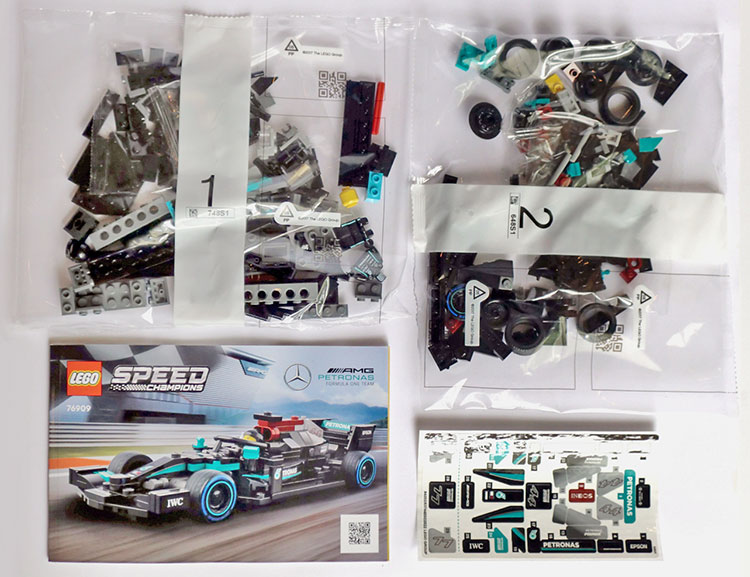
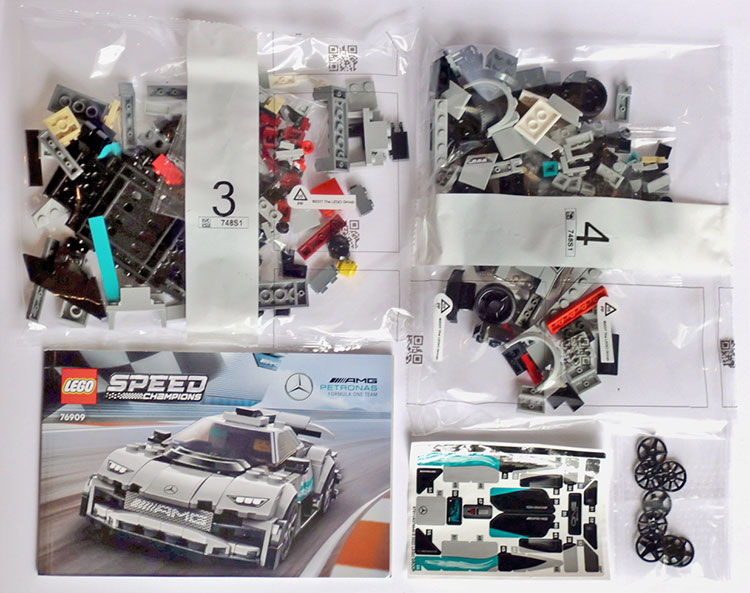
The box contains two numbered bags, an instruction booklet, and opaque sticker sheet for each vehicle. The Project One car also gets a bag of black wheel rim inserts. Parts of interest include a single black #53118 game controller (no spare though), printed Pirelli wheel covers for the F1 car, and a spare rigid hose flex tube used for the Halo device. An interesting new piece for 2022, and one unique to this set in Black, is the #86996 1x1x2/3 modified brick-with-hollow-stud. And we get a whopping 18 of them here.
It’s now time to look at each car individually before considering the set as a whole. We’ll build the Formula 1 car first, before building the Project One hybrid sports car.
Mercedes AMG F1 W12 Build Process
Bag 1 builds the driver and main chassis, while bag 2 then adds the engine cover, wings, nose and wheels. Rather than choose between 2021 drivers Lewis Hamilton and Valtteri Bottas, Lego have opted for a generic driver, though the torso printing is very nice. I would have preferred a balaclava print for under the helmet, but then you’d need a second head to use the included hairpiece. The chassis build starts by attaching front and rear axle units to a central survival cell, which is a fantastic bit of realism. The plain black game controller used for the steering wheel is a very nice feature, though I think the existing print option for this part might have been better.
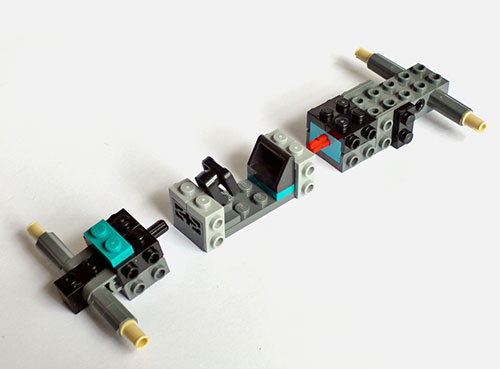
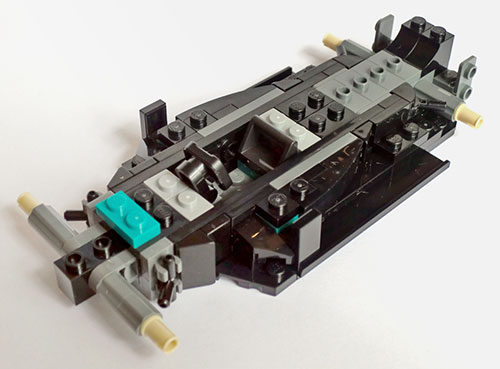
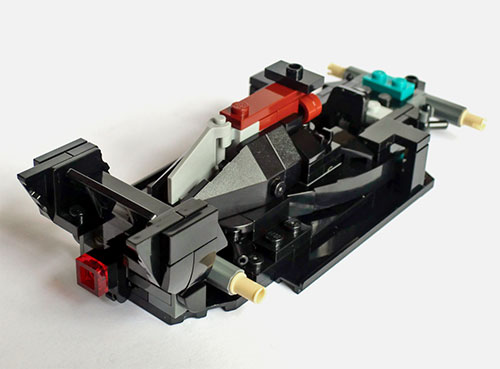
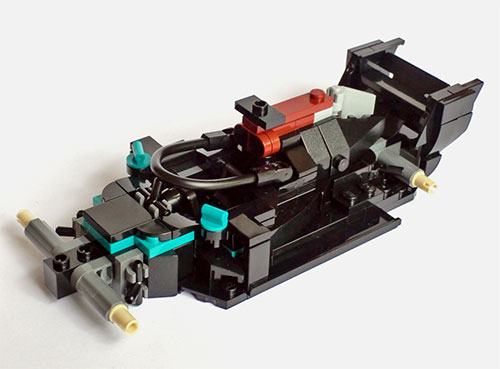
A brilliant bit of design work for the studs-out floor/sidepod sections uses 2x8 door-rail plates to lock-in the front guide vanes, which would otherwise have been easy to knock out of place. These side sections attach via a pair of #41682 brackets on either side, which makes them quite secure, but also leaves some unsightly studs in what should be a very flat and smooth area on the rear floor. Suspension strut detail is also included for both axles.
Bag 2 then builds up the airbox/engine cover area. No engine detail is included, but this would have been very hard to fit in and make accessible. The rear wing is very nicely designed, and is attached via brackets on each side, as well as two 1x2 inverted half-arches in the center. This area should really be hollow, and you can actually remove these arches with little reduction in sturdiness (plus there’s then space to add an exhaust). The Halo design is great, and I really like the parts used for the wing mirrors (#79194 in teal). The nose, front wing, and wheels then complete the build. Alternate stickers are also included to choose between Bottas’s 77 car or Hamilton’s 44 car.
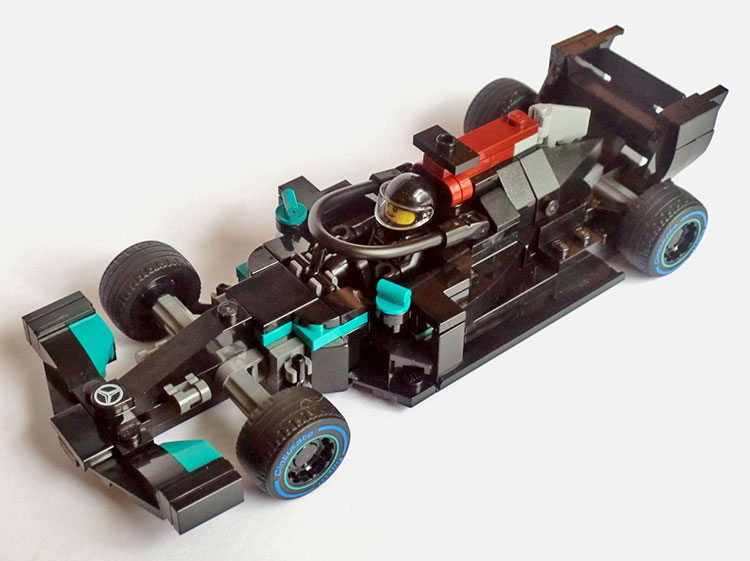
Features and Functions
The model rolls well with appropriately low ground clearance, and the Halo lifts up for excellent cockpit access. The absence of any engine is understandable here, but I do think the fixed front wing/nose section is a missed opportunity, as making this detachable is not hard to achieve.
Overall Impressions
This was an enjoyable build with some really nice details, but I’m afraid the final product is at best a mixed bag. Elements I really like are the game controller steering wheel, wing mirrors, rear wing, and sidepod guide vanes. The main problem is that the driver sits far too high, with his head peeking over the Halo and blocking the intake behind him. The transition from 1-wide nose to 4-wide cockpit is also rather abrupt and blocky, and the front wing is mounted too high. The axles stand out in grey and look much better in black. There are also not enough teal highlights for the model to look great without stickers.
I initially thought the model was too long and the wheels a bit small, but on further research this is actually accurate—modern F1 cars have become very long in wheelbase. The driver positioning is a major issue though, and can be improved by moving the driver’s feet forward one stud and then leaning him backwards. This will require changing the steering wheel mounting though to make room. Below is a comparison between the official set and a highly modified version with better driver positioning and an improved detachable nose and front wing.

Official set.

Modified driver positioning.
Mercedes AMG Project One Build Process
Now for the second car! Bag 3 builds the driver, chassis, and rear section. The driver is female, with a black AMG jacket over dark grey legs, and she gets a teal cap and ponytail as an alternative to the helmet (though only the helmet will fit when driving). The car is built on the 2021 SC chassis piece, and uses some complicated geometry at the rear to create a half-stud offset exhaust section built around taps that will later connect the cleverly angled diffuser parts.
It soon becomes apparent that there will be no space for an engine block in the back, as the shark fin is brilliantly built from a #6239 tail fin part recessed deeply within the rear chassis. It is very satisfying to rotate this into position, and it slots smoothly between angled plates to sit perfectly at the desired angle. An unusual choice is the 1x2 click-hinge bricks serving as seat backs—this does not look at all comfortable!
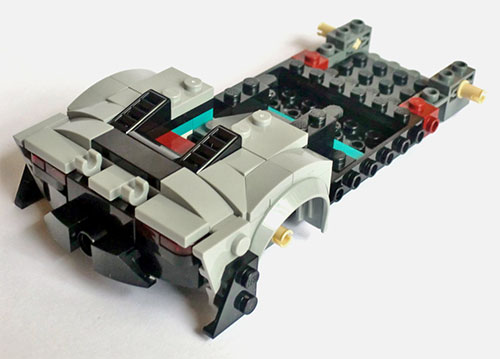
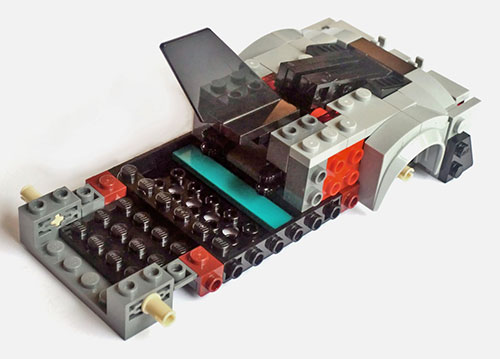
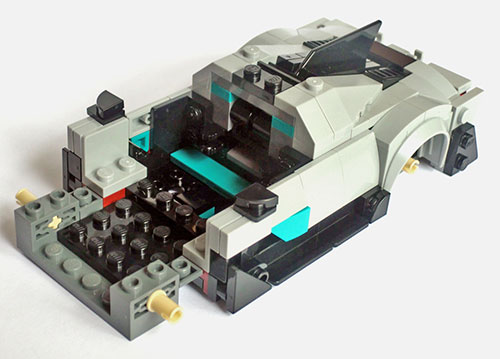
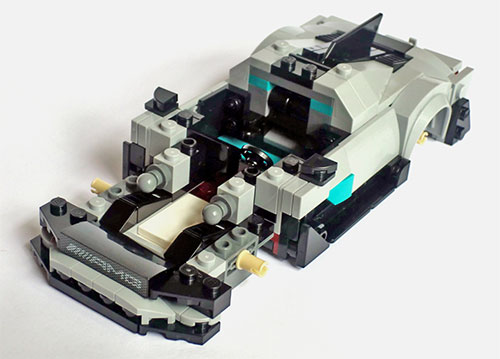
Bag 4 then builds the front half of the car. The pair of teal 1x2 curved wedge slopes on the side panels will need replacing if you want to build this without applying stickers. The front splitter plate is attached at a half-stud forward offset, and mixel ball-joints are used to slightly angle the central front bonnet over a beautifully printed AMG front grille (on the back of a 2x4 curved slope). The front comes together very nicely with the inclusion of two black fenders used to create the signature bonnet vents. Windshield, spoiler, and wheels then complete the build.
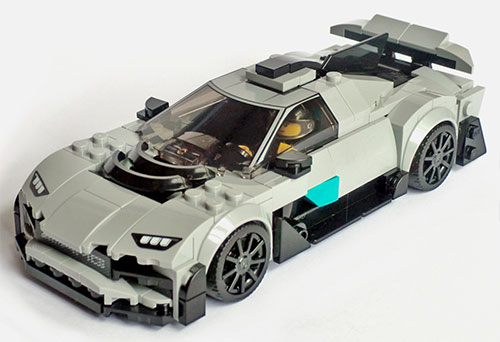
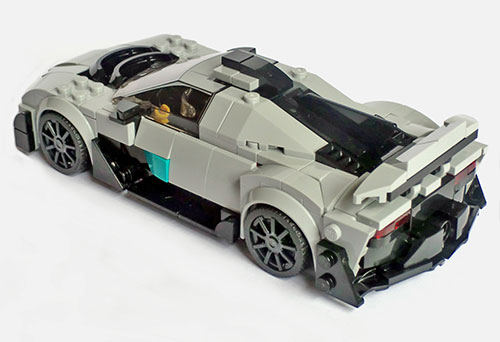
Features and Functions
The model drives well and has good cockpit access. One flaw is that the driver will only fit with her left hand raised. This is due to a couple of completely unnecessary 1x1 headlight bricks which can be easily removed. The spoiler is of course non-retractable, but does give the impression of having been raised from a flush position. It would be nice to have an engine, but this omission is quite acceptable here for the sake of the beautifully integrated shark fin.
Overall Impressions
Speaking of sharks, there’s nothing this car resembles more, with its gill-like bonnet vents and clean, sharp lines. This was a fun build with great building techniques, and the front vents and rear shark fin really look amazing. However, the final build does look a bit too long for its width, particularly with the positioning of the windscreen which needs to be a stud further forward to really capture the mid-engine look of the real car. No doubt, this has been done to accommodate the double bonnet vents, but I feel this has been achieved only by compromising the overall proportions.
One further issue is the stickered side windows, which are spread across three separate stickers on each side that don’t meet up, leaving very noticeable gaps. Other than that, this is a very nice build. Below is a comparison shot showing the effect of shortening the car by one stud (at the expense of losing one of the bonnet vents). You can judge for yourself which is the better compromise.
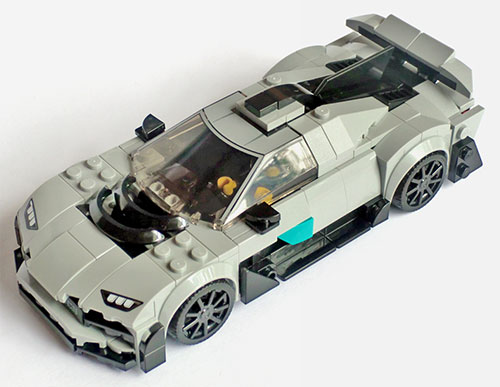
Original set.
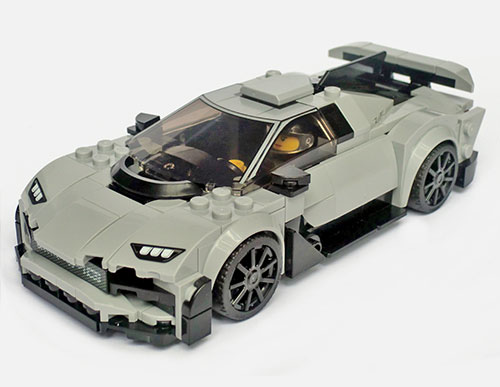
Modified set (shortened in length).
Conclusion
Between the F1 W12 and the Project One, I think the latter is the better-designed model, yet I found that both cars needed significant modification before I had versions I was happy with. Having made those changes though, I am very pleased with the results. The next review in this series will be the Aston Martin double-pack, so be sure to read that one before making up your mind between the two. I think the Aston Martin set edges out the Mercedes set as the slightly better product, though of course you can always get both—and there is definitely a lot of value to be found here with the two Mercedes cars, especially if you’re up for the challenge of a bit of tinkering and customization.
We wish to thank LEGO for providing this set for review. The opinions in this review are not supported or endorsed by LEGO.
33512